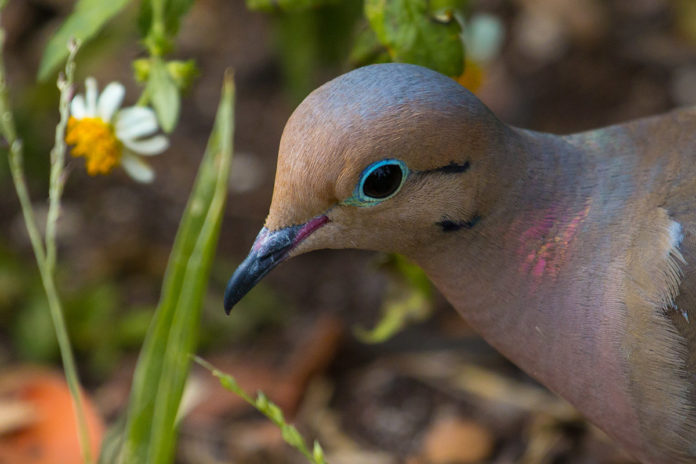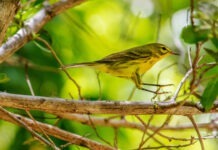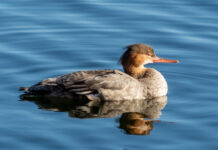She flew in and landed atop the fence, although it wasn’t immediately clear that she was a she. Mourning doves are sexually monomorphic, meaning both genders look the same, at least to humans. Males can be up to 10% bigger with slightly brighter plumage, but to really tell them apart, you need to weigh and measure them. To be extra sure, you need to move some feathers and inspect their, um, bathing suit area. (Most birds’ sex organs are recessed in what are called their cloacas.)
The question was answered, though, when another mourning dove landed next to her and started pitching woo. If this was the start of a courtship, he would have been puffing out his throat and stepping slowly towards her, stretching his neck high, then bowing low, uttering a vowelless coo. But they seemed to have advanced beyond that. Instead he sidled up to her and did what is called allopreening, reaching over with his bill and straightening out some of her neck feathers.
I expected her to fly away, because 99.99% of the time you see a male do this, the female flies away with what can only be taken as a hard no. But she just stood there.
“Ooh,” I said. “I think it’s on.”
“What’s on?” my wife asked.
“Dove sex.”
She looked up from her book.
The male preened a few more of her feathers. After three or four such sorties, the female leaned over and preened him back. Then she crouched down a bit; he jumped on top of her, fluttering his wings manically through the whole act.
Three-and-a-half seconds later, he jumped off. The technical term for the act was a “cloacal kiss.” Sure, there are plenty of potential jokes, but it was a damn efficient act of lining up parts and conveying genetic materials. So to speak.
“Is this the cuddling and cigarette part?” my wife asked, then returned to her book.
This was most likely the beginning of their pair bond. In two or three days the male would select a nest site, probably very nearby, and they would build a nest together, him bringing the female a series of twigs and her slowly assembling it. In about 30 days the chicks would fledge and the two would go for another round, or decide to switch partners. There was a chance they would raise multiple clutches, usually two eggs at a time, between now and early fall.
For the moment, though, the two mourning doves just stood there companionably, staring off into the distance.
I’m fortunate to have a workspace at The Studios of Key West on Eaton Street, where a former Masonic Lodge had been falling slowly into disrepair. For the first few years, the windows in the studios were old-school frosted glass, which was oddly isolating, offering only the vaguest notion of what was going on outside. You could look up from a computer screen and realize the sun had been down for hours.
Then TSKW raised funds and installed clear, hurricane-rated glass, making my studio a sensory explosion — a treetop view of Old Town and all its bustle. Planes pass overhead. Osprey eviscerate fish on the cross of the United Methodist Church steeple. Storm clouds roll in like moving cities. Down below, tourists do dumb things on scooters. There are so many ways to not get any work done.
Mostly I find myself staring at the mahogany tree across the street, where the white-crowned pigeons hang out.
I try to track their activities and understand their behavior, but the mahogany is so heavily leafed I know I’m missing most of what’s happening.
Mostly the white-crowns loaf and stand around without much of an agenda. Sometimes they chase each other, which I just assume is more boy-girl stuff, as white-crowned pigeons, like all doves and pigeons, are not particularly territorial.
For a while last summer I watched at least two pigeons disappearing into the same area of the tree over and over again, at all hours of the day. I was pretty sure there was a nest there, but I never managed to get a good look.
My hopes got raised the other day when I saw a scene similar to what happened on our fence take place in the mahogany. A male flew in and landed close to a female. When she didn’t fly away he sidled a little closer, and when she still didn’t fly away, even closer. Finally he took the leap and landed on her back.
I started counting, wondering if it would be as quick as with the mourning doves. One, two, three, four…
At 20 seconds I started throwing Mississippis between the numbers to make sure I didn’t count too fast. At 60 I was wondering if I should start a timer.
Somewhere around 70 seconds he jumped off and stood next to her for a few minutes. Eventually they both retreated into the tree.
I’m not really sure what sense I can make of putting these two incidents together, other than to say hey, it’s breeding season, keep your eyes open. Maybe have a stopwatch ready.






















